Prison
| Criminology and penology |
|---|
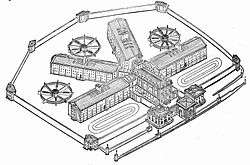 |

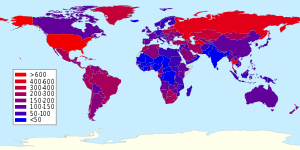
A prison,[lower-alpha 1] also known as a correctional facility, jail,[lower-alpha 2] gaol (dated, British and Australian English), penitentiary (American English), detention center[lower-alpha 3] (American English), or remand center[lower-alpha 4] is a facility in which inmates are forcibly confined and denied a variety of freedoms under the authority of the state. Prisons are most commonly used within a criminal justice system: people charged with crimes may be imprisoned until their trial; those pleading or being found guilty of crimes at trial may be sentenced to a specified period of imprisonment.
Prisons can also be used as a tool of political repression by authoritarian regimes. Their perceived opponents may be imprisoned for political crimes, often without trial or other legal due process; this use is illegal under most forms of international law governing fair administration of justice. In times of war, prisoners of war or detainees may be detained in military prisons or prisoner of war camps, and large groups of civilians might be imprisoned in internment camps.
In American English, prison and jail are usually treated as having separate definitions. The term prison or penitentiary tends to describe institutions that incarcerate people for longer periods of time, such as many years, and are operated by the state or federal governments. The term jail tends to describe institutions for confining people for shorter periods of time (e.g. for shorter sentences or pre-trial detention) and are usually operated by local governments.[4] Outside of North America, prison and jail have the same meaning.
Common slang terms for a prison include: "the pokey", "the slammer", "the clink", "the joint", "the calaboose", "the hoosegow" and "the big house". Slang terms for imprisonment include: "behind bars", "in stir" and "up the river" (a possible reference to Sing Sing).
History
Ancient and medieval
The use of prisons can be traced back to the rise of the state as a form of social organization. Corresponding with the advent of the state was the development of written language, which enabled the creation of formalized legal codes as official guidelines for society. The best known of these early legal codes is the Code of Hammurabi, written in Babylon around 1750 BC. The penalties for violations of the laws in Hammurabi's Code were almost exclusively centered on the concept of lex talionis ("the law of retaliation"), whereby people were punished as a form of vengeance, often by the victims themselves. This notion of punishment as vengeance or retaliation can also be found in many other legal codes from early civilizations, including the ancient Sumerian codes, the Indian Manama Dharma Astra, the Hermes Trismegistus of Egypt, and the Israelite Mosaic Law.[5]
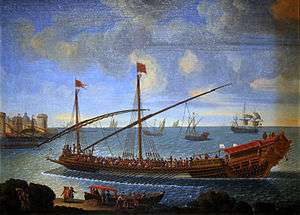
Some Ancient Greek philosophers, such as Plato, began to develop ideas of using punishment to reform offenders instead of simply using it as retribution. Imprisonment as a penalty was used initially for those who could not afford to pay their fines. Eventually, since impoverished Athenians could not pay their fines, leading to indefinite periods of imprisonment, time limits were set instead.[6] The prison in Ancient Athens was known as the desmoterion ("place of chains").[7]
The Romans were among the first to use prisons as a form of punishment, rather than simply for detention. A variety of existing structures were used to house prisoners, such as metal cages, basements of public buildings, and quarries. One of the most notable Roman prisons was the Mamertine Prison, established around 640 B.C. by Ancus Marcius. The Mamertine Prison was located within a sewer system beneath ancient Rome and contained a large network of dungeons where prisoners were held in squalid conditions,[8] contaminated with human waste. Forced labor on public works projects was also a common form of punishment. In many cases, citizens were sentenced to slavery, often in ergastula (a primitive form of prison where unruly slaves were chained to workbenches and performed hard labor).
During the Middle Ages in Europe, castles, fortresses, and the basements of public buildings were often used as makeshift prisons. The possession of the right and the capability to imprison citizens, however, granted an air of legitimacy to officials at all levels of government, from kings to regional courts to city councils; and the ability to have someone imprisoned or killed served as a signifier of who in society possessed power or authority over others.[9] Another common punishment was sentencing people to galley slavery, which involved chaining prisoners together in the bottoms of ships and forcing them to row on naval or merchant vessels.
Modern era
From the late 17th century and during the 18th century, popular resistance to public execution and torture became more widespread both in Europe and in the United States. Particularly under the Bloody Code, with few sentencing alternatives, imposition of the death penalty for petty crimes, such as theft, was proving increasingly unpopular with the public; many jurors were refusing to convict defendants of petty crimes when they knew the defendants would be sentenced to death. Rulers began looking for means to punish and control their subjects in a way that did not cause people to associate them with spectacles of tyrannical and sadistic violence. They developed systems of mass incarceration, often with hard labor, as a solution.[10][11][12] The prison reform movement that arose at this time was heavily influenced by two somewhat contradictory philosophies. The first was based in Enlightenment ideas of utilitarianism and rationalism, and suggested that prisons should simply be used as a more effective substitute for public corporal punishments such as whipping, hanging, etc. This theory, referred to as deterrence, claims that the primary purpose of prisons is to be so harsh and terrifying that they deter people from committing crimes out of fear of going to prison. The second theory, which saw prisons as a form of rehabilitation or moral reform, was based on religious ideas that equated crime with sin, and saw prisons as a place to instruct prisoners in Christian morality, obedience and proper behavior. These later reformers believed that prisons could be constructed as humane institutions of moral instruction, and that prisoners' behavior could be "corrected" so that when they were released, they would be model members of society.[13]
The concept of the modern prison largely remained unknown until the early 19th-century. Punishment usually consisted of physical forms of punishment, including capital punishment, mutilation, flagellation (whipping), branding, and non-physical punishments, such as public shaming rituals (like the stocks).[14] From the Middle Ages up to the 16th and 17th centuries in Europe, imprisonment was rarely used as a punishment in its own right, and prisons were mainly to hold those awaiting trial and convicts awaiting punishment.
However, an important innovation at the time was the Bridewell House of Corrections, located at Bridewell Palace in London, which resulted in the building of other houses of correction. These houses held mostly petty offenders, vagrants, and the disorderly local poor. In these facilities, inmates were given jobs, and through prison labor they were taught how to work for a living. By the end of the 17th century, houses of correction were absorbed into local prison facilities under the control of the local justice of the peace.[10]
Transportation, prison ships and penal colonies
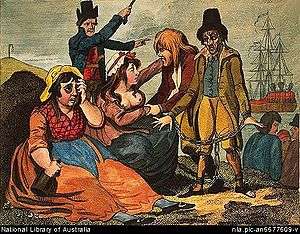
England used penal transportation of convicted criminals (and others generally young and poor) for a term of indentured servitude within the general population of British America between the 1610s and 1776. The Transportation Act 1717 made this option available for lesser crimes, or offered it by discretion as a longer-term alternative to the death penalty, which could theoretically be imposed for the growing number of offenses. The substantial expansion of transportation was the first major innovation in eighteenth-century British penal practice.[15] Transportation to America was abruptly suspended by the Criminal Law Act 1776 (16 Geo. 3 c.43)[16][17] with the start of the American Rebellion. While sentencing to transportation continued, the act instituted a punishment policy of hard labour instead. The suspension of transport also prompted the use of prisons for punishment and the initial start of a prison building program.[18] Britain would resume transportation to specifically planned penal colonies in Australia between 1788 and 1868.[lower-alpha 5]

Gaols at the time were run as business ventures, and contained both felons and debtors; the latter were often housed with their wives and younger children. The gaolers made their money by charging the inmates for food, drink, and other services, and the system was generally corruptible.[19] One reform of the seventeenth century was the establishment of the London Bridewell as a house of correction for women and children. It was the first facility to make any medical services available to prisoners.
With the widely used alternative of penal transportation halted in the 1770s, the immediate need for additional penal accommodations emerged. Given the undeveloped institutional facilities, old sailing vessels, termed hulks, were the most readily available and expandable choice to be used as places of temporary confinement.[20] While conditions on these ships were generally appalling, their use and the labor thus provided set a precedent which persuaded many people that mass incarceration and labour were viable methods of crime prevention and punishment. The turn of the 19th century would see the first movement toward Prison reform, and by the 1810s, the first state prisons and correctional facilities were built, thereby inaugurating the modern prison facilities available today.
France also sent criminals to overseas penal colonies, including Louisiana, in the early 18th century.[21] Penal colonies in French Guiana operated until 1952, such as the notable Devil's Island (Île du Diable). Katorga prisons were harsh work camps established in the 17th century in Russia, in remote underpopulated areas of Siberia and the Russian Far East, that had few towns or food sources. Siberia quickly gained its fearful connotation of punishment.[22]
Prison reform movement
John Howard was one of the most notable early prison reformers.[lower-alpha 7] After having visited several hundred prisons across England and Europe, in his capacity as high sheriff of Bedfordshire, he published The State of the Prisons in 1777.[25] He was particularly appalled to discover prisoners who had been acquitted but were still confined because they couldn't pay the gaoler's fees. He proposed wide-ranging reforms to the system, including the housing of each prisoner in a separate cell; the requirements that staff should be professional and paid by the government, that outside inspection of prisons should be imposed, and that prisoners should be provided with a healthy diet and reasonable living conditions. The prison reform charity, the Howard League for Penal Reform, was established in 1866 by his admirers.[26]
Following Howard's agitation, the Penitentiary Act was passed in 1779. This introduced solitary confinement, religious instruction, a labor regime, and proposed two state penitentiaries (one for men and one for women). However, these were never built due to disagreements in the committee and pressures from wars with France, and gaols remained a local responsibility. But other measures passed in the next few years provided magistrates with the powers to implement many of these reforms, and eventually, in 1815, gaol fees were abolished.
Quakers were prominent in campaigning against and publicizing the dire state of the prisons at the time. Elizabeth Fry documented the conditions that prevailed at Newgate prison, where the ladies' section was overcrowded with women and children, some of whom had not even received a trial. The inmates did their own cooking and washing in the small cells in which they slept on straw. In 1816, Fry was able to found a prison school for the children who were imprisoned with their parents. She also began a system of supervision and required the women to sew and to read the Bible. In 1817, she helped found the Association for the Reformation of the Female Prisoners in Newgate.
Development of the modern prison
The theory of the modern prison system was born in London, influenced by the utilitarianism of Jeremy Bentham. Bentham's panopticon introduced the principle of observation and control that underpins the design of the modern prison. The notion of prisoners being incarcerated as part of their punishment and not simply as a holding state until trial or hanging, was at the time revolutionary. His views influenced the establishment of the first prisons used as criminal rehabilitation centers. At a time when the implementation of capital punishment for a variety of relatively trivial offences was on the decline, the notion of incarceration as a form of punishment and correction held great appeal to reform-minded thinkers and politicians.
In the first half of the 19th century, capital punishment came to be regarded as inappropriate for many crimes that it had previously been carried out for, and by the mid-19th century, imprisonment had replaced the death penalty for the most serious offenses except for murder.[10]
The first state prison in England was the Millbank Prison, established in 1816 with a capacity for just under 1000 inmates. By 1824, 54 prisons had adopted the disciplinary system advocated by the SIPD.[27] By the 1840s, penal transportation to Australia and the use of hulks was on the decline, and the Surveyor-General of convict prisons, Joshua Jebb, set an ambitious program of prison building in the country, with one large prison opening per year. Pentonville prison opened in 1842, beginning a trend of ever increasing incarceration rates and the use of prison as the primary form of crime punishment.[28] Robert Peel's Gaols Act of 1823 introduced regular visits to prisoners by chaplains, provided for the payment of gaolers and prohibited the use of irons and manacles.
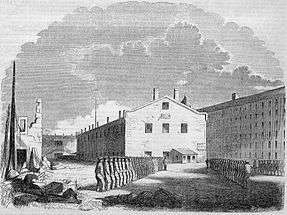
In 1786, the state of Pennsylvania passed a law which mandated that all convicts who had not been sentenced to death would be placed in penal servitude to do public works projects such as building roads, forts, and mines. Besides the economic benefits of providing a free source of hard labor, the proponents of the new penal code also thought that this would deter criminal activity by making a conspicuous public example of consequences of breaking the law. However, what actually ended up happening was frequent spectacles of disorderly conduct by the convict work crews, and the generation of sympathetic feelings from the citizens who witnessed the mistreatment of the convicts. The laws quickly drew criticism from a humanitarian perspective (as cruel, exploitative and degrading) and from a utilitarian perspective (as failing to deter crime and delegitimizing the state in the eyes of the public). Reformers such as Benjamin Rush came up with a solution that would enable the continued used of forced labor, while keeping disorderly conduct and abuse out of the eyes of the public. They suggested that prisoners be sent to secluded "houses of repentance" where they would be subjected (out of the view of the public) to "bodily pain, labour, watchfulness, solitude, and silence ... joined with cleanliness and a simple diet".[29][lower-alpha 8]
Pennsylvania soon put this theory into practice, and turned its old jail at Walnut Street in Philadelphia into a state prison, in 1790. This prison was modeled on what became known as the "Pennsylvania system" (or "separate system"), and placed all prisoners into solitary cells with nothing other than religious literature, and forced them to be completely silent to reflect on their wrongs.[30] New York soon built the Newgate state prison in Greenwich Village, which was modeled on the Pennsylvania system,[31] and other states followed.
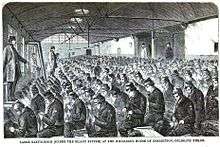
But by 1820 faith in the efficacy of legal reform had declined as statutory changes had no discernible effect on the level of crime, and the prisons, where prisoners shared large rooms and booty including alcohol, had become riotous and prone to escapes. In response, New York developed the Auburn system in which prisoners were confined in separate cells and prohibited from talking when eating and working together, implementing it at Auburn State Prison and Sing Sing at Ossining. The aim of this was rehabilitative: the reformers talked about the penitentiary serving as a model for the family and the school and almost all the states adopted the plan (though Pennsylvania went even further in separating prisoners). The system's fame spread and visitors to the U.S. to see the prisons included de Tocqueville who wrote Democracy in America as a result of his visit.[32]
The use of prisons in Continental Europe was never as popular as it became in the English-speaking world, although state prison systems were largely in place by the end of the 19th century in most European countries. After the unification of Italy in 1861, the government reformed the repressive and arbitrary prison system they inherited, and modernized and secularized criminal punishment by emphasizing discipline and deterrence.[33] Italy developed an advanced penology under the leadership of Cesare Lombroso (1835–1909).[34]
Another prominent prison reformer who made important contributions was Alexander Paterson[35] who advocated for the necessity of humanising and socialising methods within the prison system in Great Britain and America.[36]
Design
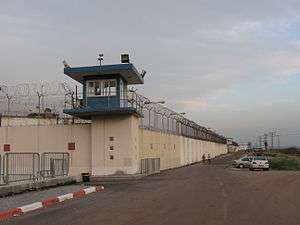
Security
Prisons are normally surrounded by fencing, walls, earthworks, geographical features, or other barriers to prevent escape. Multiple barriers, concertina wire, electrified fencing, secured and defensible main gates, armed guard towers, security lighting, motion sensors, dogs and roving patrols may all also be present depending on the level of security.[37][38]
Remotely controlled doors, CCTV monitoring, alarms, cages, restraints, nonlethal and lethal weapons, riot-control gear and physical segregation of units and prisoners may all also be present within a prison to monitor and control the movement and activity of prisoners within the facility.[lower-alpha 9]

Modern prison designs have increasingly sought to restrict and control the movement of prisoners throughout the facility and also to allow a smaller prison staff to monitor prisoners directly; often using a decentralized "podular" layout.[39][40] (In comparison, 19th-century prisons had large landings and cell blocks which permitted only intermittent observation of prisoners.) Smaller, separate and self-contained housing units known as "pods" or "modules" are designed to hold 16 to 50 prisoners and are arranged around exercise yards or support facilities in a decentralized "campus" pattern. A small number of prison officers, sometimes a single officer, supervise each pod. The pods contain tiers of cells arranged around a central control station or desk from which a single officer can monitor all the cells and the entire pod, control cell doors and communicate with the rest of the prison.
Pods may be designed for high-security "indirect supervision", in which officers in segregated and sealed control booths monitor smaller numbers of prisoners confined to their cells. An alternative is "direct supervision", in which officers work within the pod and directly interact with and supervise prisoners, who may spend the day outside their cells in a central "dayroom" on the floor of the pod. Movement in or out of the pod to and from exercise yards, work assignments or medical appointments can be restricted to individual pods at designated times and is generally centrally controlled. Goods and services, such as meals, laundry, commissary, educational materials, religious services and medical care can increasingly be brought to individual pods or cells as well.[41] Some modern prisons may exclude certain inmates from the general population, usually for safety reasons, such as those within solitary confinement, celebrities, political figures and former law enforcement officers, those convicted of sexual crimes and/or crimes against children, or those on the medical wing or protective custody.[42]
Inmate security classifications
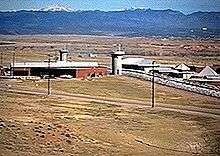
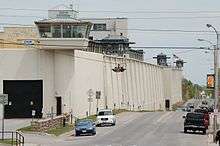
.jpg)
Generally, when an inmate arrives at a prison, they go through a security classification screening and risk assessment that determines where they will be placed within the prison system. Classifications are assigned by assessing the prisoner's personal history and criminal record, and through subjective determinations made by intake personnel (which include mental health workers, counselors, prison unit managers, and others). This process will have a major impact on the prisoner's experience, determining their security level, educational and work programs, mental health status (e.g. will they be placed in a mental health unit), and many other factors. This sorting of prisoners is one of the fundamental techniques through which the prison administration maintains control over the inmate population, and creates an orderly and secure prison environment.[43][44][45] At most prisons, prisoners are made to wear a prison uniform.
The levels of security within a prison system are categorized differently around the world, but tend to follow a distinct pattern. At one end of the spectrum are the most secure facilities ("maximum security"), which typically hold prisoners that are considered dangerous, disruptive or likely to try to escape. Furthermore, in recent times, supermax prisons have been created where the custody level goes beyond maximum security for people such as terrorists or political prisoners deemed a threat to national security, and inmates from other prisons who have a history of violent or other disruptive behavior in prison or are suspected of gang affiliation. These inmates have individual cells and are kept in lockdown, often for more than 23 hours per day. Meals are served through "chuck-holes" in the cell door, and each inmate is allotted one hour of outdoor exercise per day, alone. They are normally permitted no contact with other inmates and are under constant surveillance via closed-circuit television cameras.[46]
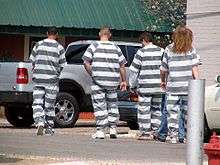
On the other end are "minimum security" prisons which are most often used to house those for whom more stringent security is deemed unnecessary. For example, while white-collar crime rarely results in incarceration, when it does offenders are almost always sent to minimum-security prisons due to them having committed nonviolent crimes.[47] Lower-security prisons are often designed with less restrictive features, confining prisoners at night in smaller locked dormitories or even cottage or cabin-like housing while permitting them free movement around the grounds to work or activities during the day. Some countries (such as Britain) also have "open" prisons where prisoners are allowed home-leave or part-time employment outside of the prison. Suomenlinna Island facility in Finland is an example of one such "open" correctional facility. The prison has been open since 1971 and, as of September 2013, the facility's 95 male prisoners leave the prison grounds on a daily basis to work in the corresponding township or commute to the mainland for either work or study. Prisoners can rent flat-screen televisions, sound systems, and mini-refrigerators with the prison-labor wages that they can earn—wages range between 4.10 and €7.30 per hour. With electronic monitoring, prisoners are also allowed to visit their families in Helsinki and eat together with the prison staff. Prisoners in Scandinavian facilities are permitted to wear their own clothes.[48]
Common facilities
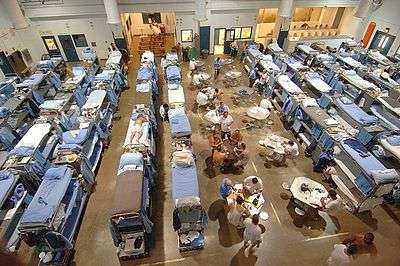
Modern prisons often hold hundreds or thousands of inmates, and must have facilities onsite to meet most of their needs, including dietary, health, fitness, education, religious practices, entertainment, and many others. Conditions in prisons vary widely around the world, and the types of facilities within prisons depend on many intersecting factors including funding, legal requirements, and cultural beliefs/practices. Nevertheless, in addition to the cell blocks that contain the prisoners, also there are certain auxiliary facilities that are common in prisons throughout the world.
Kitchen and dining
Prisons generally have to provide food for a large number of individuals, and thus are generally equipped with a large institutional kitchen. There are many security considerations, however, that are unique to the prison dining environment. For instance, cutlery equipment must be very carefully monitored and accounted for at all times, and the layout of prison kitchens must be designed in a way that allows staff to observe activity of the kitchen staff (who are usually prisoners). The quality of kitchen equipment varies from prison to prison, depending on when the prison was constructed, and the level of funding available to procure new equipment. Prisoners are often served food in a large cafeteria with rows of tables and benches that are securely attached to the floor. However, inmates that are locked in control units, or prisons that are on "lockdown" (where prisoners are made to remain in their cells all day) have trays of food brought to their cells and served through "chuck-holes" in the cell door.[49] It is said that prison food of many developed countries is adequate to maintain health and dieting.[50]
Healthcare
Prisons in wealthy, industrialized nations provide medical care for most of their inmates. Additionally, prison medical staff play a major role in monitoring, organizing, and controlling the prison population through the use of psychiatric evaluations and interventions (psychiatric drugs, isolation in mental health units, etc.). Prison populations are largely from poor minority communities that experience greater rates of chronic illness, substance abuse, and mental illness than the general population. This leads to a high demand for medical services, and in countries such as the US that don't provide tax-payer funded healthcare, prison is often the first place that people are able to receive medical treatment (which they couldn't afford outside).[51][52][53]
Prison medical facilities include primary care, mental health services, dental care, substance abuse treatment, and other forms of specialized care, depending on the needs of the inmate population. Health care services in many prisons have long been criticized as inadequate, underfunded, and understaffed, and many prisoners have experienced abuse and mistreatment at the hands of prison medical staff who are entrusted with their care.[51][53][54]
In the United States, a million people who are incarcerated suffer from mental illness without any assistance or treatment for their condition and the tendency of a convicted criminal to reoffend, known as the rate of recidivism, is unusually high for those with the most serious disorders.[55] Analysis of data in 2000 from several forensic hospitals in California, New York and Oregon found that with treatment the rate of recidivism was "much lower" than untreated mentally ill offenders.[55]
Library and educational facilities

Some prisons provide educational programs for inmates that can include basic literacy, secondary education, or even college education. Prisoners seek education for a variety of reasons, including the development of skills for after release, personal enrichment and curiosity, finding something to fill their time, or trying to please prison staff (which can often secure early release for good behavior). However, the educational needs of prisoners often come into conflict with the security concerns of prison staff and with a public that wants to be "tough on crime" (and thus supports denying prisoners access to education). Whatever their reasons for participating in educational programs, prison populations tend to have very low literacy rates and lack of basic mathematical skills, and many have not completed secondary education. This lack of basic education severely limits their employment opportunities outside of prison, leading to high rates of recidivism, and research has shown that prison education can play a significant role in helping prisoners reorient their lives and become successful after reentry.[56][57]
Many prisons also provide a library where prisoners can check out books, or do legal research for their cases.[lower-alpha 10] Often these libraries are very small, consisting of a few shelves of books. In some countries, such as the United States, drastic budget cuts have resulted in many prison libraries being shut down. Meanwhile, many nations that have historically lacked prison libraries are starting to develop them.[58] Prison libraries can dramatically improve the quality of life for prisoners, who have large amounts of empty time on their hands that can be occupied with reading. This time spent reading has a variety of benefits including improved literacy, ability to understand rules and regulations (leading to improved behavior), ability to read books that encourage self-reflection and analysis of one's emotional state, consciousness of important real-world events, and education that can lead to successful re-entry into society after release.[59][60]
Recreation and fitness
Many prisons provide limited recreational and fitness facilities for prisoners. The provision of these services is controversial, with certain elements of society claiming that prisons are being "soft" on inmates, and others claiming that it is cruel and dehumanizing to confine people for years without any recreational opportunities. The tension between these two opinions, coupled with lack of funding, leads to a large variety of different recreational procedures at different prisons. Prison administrators, however, generally find the provision of recreational opportunities to be useful at maintaining order in the prisons, because it keeps prisoners occupied and provides leverage to gain compliance (by depriving prisoners of recreation as punishment). Examples of common facilities/programs that are available in some prisons are: gyms and weightlifting rooms, arts and crafts, games (such as cards, chess, or bingo), television sets, and sports teams.[61] Additionally, many prisons have an outdoor recreation area, commonly referred to as an "exercise yard".
Control units
Most prisoners are part of the "general population" of the prison, members of which are generally able to socialize with each other in common areas of the prison.[62] A control unit or segregation unit (also called a "block" or "isolation cell") is a highly secure area of the prison, where inmates are placed in solitary confinement to isolate them from the general population.[63] Other prisoners that are often segregated from the general population include those who are in protective custody, or who are on suicide watch, and those whose behavior presents a threat to other prisoners.
Other facilities

In addition to the above facilities, others that are common include prison factories and workshops, visiting areas, mail rooms, telephone and computer rooms, a prison store (often called a "canteen") where prisoners can purchase goods, and a death row where prisoners who have been sentenced to death await execution.
Special types
Youth detention facilities
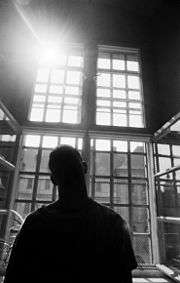
Prisons for juveniles are known by a variety of names, including "youth detention facilities", "juvenile detention centers", and "reformatories". The purpose of youth detention facilities is to keep young offenders away from the public, while working towards rehabilitation.[64]The idea of separately treating youthful and adult offenders is a relatively modern idea. The earliest known use of the term "juvenile delinquency" was in London in 1816, from where it quickly spread to the United States. The first juvenile correctional institution in the United States opened in 1825 in New York City. By 1917, juvenile courts had been established in all but 3 states.[65] It was estimated that in 2011 more than 95,000 juveniles were locked up in prisons and jails in the United States (the largest youth prisoner population in the world).[66] Besides prisons, many other types of residential placement exist within juvenile justice systems, including youth homes, community-based programs, training schools and boot camps.[65]
Like adult facilities, youth detention centers in some countries are experiencing overcrowding due to large increases in incarceration rates of young offenders. Crowding can create extremely dangerous environments in juvenile detention centers and juvenile correctional facilities. Overcrowding may also lead to the decrease in availability to provide the youth with much needed and promised programs and services while they are in the facility. Many times the administration is not prepared to handle the large number of residents and therefore the facilities can become unstable and create instability in simple logistics.[67]
In addition to overcrowding, juvenile prisons are questioned for their overall effectiveness in rehabilitating youth. Many critics note high juvenile recidivism rates, and the fact that the most of the youths that are incarcerated are those from lower socio-economic classes (who often suffer from broken families, lack of educational/job opportunities, and violence in their communities).[65][67]
Women's prisons
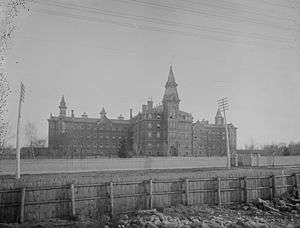
In the 19th century, a growing awareness that female prisoners had different needs to male prisoners led to the establishment of dedicated prisons for women.[68] In modern times, it is the norm for female inmates to be housed in either a separate prison or a separate wing of a unisex prison. The aim is to protect them from physical and sexual abuse that would otherwise occur.
In the Western world, the guards of women's prisons are usually female, though not always.[69][70] For example, in federal women’s correction facilities of the United States, 70% of guards are male.[71] Rape and sexual offences remain commonplace in many women's prisons, and are usually underreported.[72] Two studies in the late 2000s noted that as a high proportion of female inmates have experienced sexual abuse in the past, they are particularly vulnerable to further abuse.[73][74]
The needs of mothers during pregnancy and childbirth often conflict with the demands of the prison system. The Rebecca Project, a non-profit organization that campaigns for women's rights issues, reports that "In 2007, the Bureau of Justice Statistics stated that, on average, 5% of women who enter into state prisons are pregnant and in jails [local prisons] 6% of women are pregnant".[75] The standard of care that female prisoners receive before and after giving birth is often far worse than the standard expected by the general population, and sometimes almost none is given.[75] In other countries such as the United Kingdom, it is no longer compulsory for female prisoners to be restrained while giving birth.[76]
Military prisons and prisoner-of-war camps
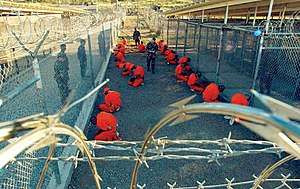
Prisons have formed parts of military systems since the French Revolution. France set up its system in 1796. They were modernized in 1852 and since their existence, are used variously to house prisoners of war, unlawful combatants, those whose freedom is deemed a national security risk by military or civilian authorities, and members of the military found guilty of a serious crime. Military prisons in the United States have also been converted to civilian prisons, to include Alcatraz Island. Alcatraz was formerly a military prison for soldiers during the American Civil War.
In the American Revolution, British prisoners held by the U.S. were assigned to local farmers as laborers. The British kept American sailors in broken down ship hulks with high death rates.
In the Napoleonic wars, the broken down hulks were still in use for naval prisoners. One French surgeon recalled his captivity in Spain, where scurvy, diarrhea, dysentery, and typhus abounded, and prisoners died by the thousands:
- "These great trunks of ships were immense coffins, in which living men were consigned to a slow death.... [In the hot weather we had] black army bread full of gritty particles, biscuit full of maggots, salt meat that was already decomposing, rancid lard, spoiled cod, [and] stale rice, peas, and beans."[77]
In the American Civil War, at first prisoners of war were released, after they promised not to fight again unless formally exchanged. When the Confederacy refused to exchange black prisoners the system broke down, and each side built large-scale POW camps. Conditions in terms of housing, food, and medical care were bad in the Confederacy, and the Union retaliated by imposing harsh conditions.[78]
By 1900 the legal framework of the Geneva and Hague Convention provided considerable protection. In the First World War, millions of prisoners were held on both sides, with no major atrocities. Officers received privileged treatment. There was an increase in the use of forced labor throughout Europe. Food and medical treatment were generally comparable to what active duty soldiers received, and housing was much better than front-line conditions.[79]
Political prisons and administrative detention
Political prisoners are people who have been imprisoned because of their political beliefs, activities and affiliations. There is much debate about who qualifies as a "political prisoner". The category of "political prisoner" is often contested, and many regimes that incarcerate political prisoners often claim that they are merely "criminals". Others who are sometimes classified as "political prisoners" include prisoners who were politicized in prison, and are subsequently punished for their involvement with political causes.[80][81][lower-alpha 11]
Many countries maintain or have in the past had a system of prisons specifically intended for political prisoners. In some countries, dissidents can be detained, tortured, executed, and/or "disappeared" without trial. This can happen either legally, or extralegally (sometimes by falsely accusing people and fabricating evidence against them).[82]
Administrative detention is a classification of prisons or detention centers where people are held without trial.
Psychiatric facilities
Some psychiatric facilities have characteristics of prisons, particularly when confining patients who have committed a crime and are considered dangerous.[83] In addition, many prisons have psychiatric units dedicated to housing offenders diagnosed with a wide variety of mental disorders. The United States government refers to psychiatric prisons as "Federal Medical Centers (FMC)".
Prison population
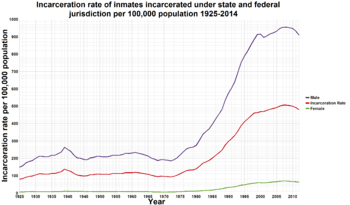
Some jurisdictions refer to the prison population (total or per-prison) as the prison muster.[84]
In 2010, the International Centre for Prison Studies that at least 10.1 million people were imprisoned worldwide.[85]
As of 2012 the United States of America had the world's largest prison population, with over 2.3 million people in American prisons or jails—up from 744,000 in 1985—making 1 in every 100 American adults a prisoner. That same year it was also reported that the United States government spent an estimated US$37 billion to maintain prisons.[86] CNBC estimated that the cost of maintaining the US prison system was US$74 billion per year.[87][lower-alpha 12]
Not all countries have experienced a rise in prison population; Sweden closed four prisons in 2013 due to a significant drop in the number of inmates. The head of Sweden's prison and probation services characterised the decrease in the number of Swedish prisoners as "out-of-the-ordinary", with prison numbers in Sweden falling by around 1% a year since 2004.[88]
Economics of the prison industry
In the United States alone, more than $74 billion per year is spent on prisons, with over 800,000 people employed in the prison industry.[89] As the prison population grows, revenues increase for a variety of small and large businesses that construct facilities, and provide equipment (security systems, furniture, clothing), and services (transportation, communications, healthcare, food) for prisons. These parties have a strong interest in the expansion of the prison system since their development and prosperity directly depends on the number of inmates.[90][91]
The prison industry also includes private businesses that benefit from the exploitation of the prison labor.[92][93] Some scholars, using the term prison-industrial complex, have argued that the trend of "hiring out prisoners" is a continuation of the slavery tradition, pointing out that the Thirteenth Amendment to the United States Constitution freed slaves but allowed forced labor for people convicted of crimes.[94][95] Prisons are very attractive to employers, because prisoners can be made to perform a great array of jobs, under conditions that most free laborers wouldn't accept (and would be illegal outside of prisons): sub-minimum wage payments, no insurance, no collective bargaining, lack of alternative options, etc.[96] Prison labor can soon deprive the free labor of jobs in a number of sectors, since the organized labor turns out to be uncompetitive compared to the prison counterpart.[96][97][98]
Social effects
Internal
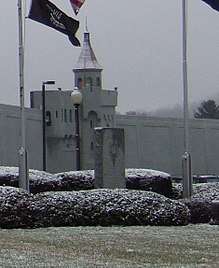
Prisons can be difficult places to live and work in, even in developed countries in the present day. By their very definition, prisons house individuals who may be prone to violence and rule-breaking.[99] It is also typical that a high proportion of inmates have mental health concerns. A 2014 US report found that this included 64% of local jail inmates, 54% of state prisoners and 45% of federal prisoners.[100] The environment may be worsened by overcrowding; poor sanitation and maintenance; violence by prisoners against other prisoners or staff; staff misconduct; prison gangs; self-harm; and the widespread smuggling of illegal drugs and other contraband.[101] In some cases, disorder has escalated into a full-scale prison riot. Academic research has found that poor conditions tend to increase the likelihood of violence within prisons.[102][103][104]
External
Prisoners can face difficulty re-integrating back into society upon their release. They often have difficulty finding work, earn less money when they do find work, and experience a wide range of medical and psychological issues. Many countries have a high recidivism rate. According to the Bureau of Justice Statistics, 67.8% of released prisoners in the United States are rearrested within three years and 76.6% are rearrested within five years.[105] If the prisoner has a family, they are likely to suffer socially and economically from their absence.[106][107][108]
If a society has a very high imprisonment rate, these effects become noticeable not just on family units, but also on entire poor communities.[106][107] The expensive cost of maintaining a high imprisonment rate also costs money that must come at the expense of either the taxpayer or other government agencies.[109][110]
Theories of punishment and criminality
A variety of justifications and explanations are put forth for why people are imprisoned by the state. The most common of these are:[111]
- Rehabilitation:[lower-alpha 13] Theories of rehabilitation argue that the purpose of imprisonment is to change prisoners' lives in a way that will make them productive and law-abiding members of society once they are released. The idea was promoted by 19th century reformers, who promoted prisons as a humane alternative to harsh punishments of the past.[13] Many governments and prison systems have adopted rehabilitation as an official aim.[112] In the United States and Canada, prison agencies are often referred to as "Corrections" services for this reason.
- Deterrence: Theories of deterrence argue that by sentencing criminals to extremely harsh penalties, other people who might be considering criminal activities will be so terrified of the consequences that they will choose not to commit crimes out of fear.
- Incapacitation: Theories of incapacitation argue that while prisoners are incarcerated, they will be unable to commit crimes, thus keeping communities safer.
- Retribution: Theories of retribution argue that the purpose of imprisonment is to cause a sufficient level of misery to the prisoner, in proportion to the perceived seriousness of their crime. These theories do not necessarily focus on whether or not a particular punishment benefits the community, but instead are based upon a belief that some kind of moral balance will be achieved by "paying back" the prisoner for the wrongs they have committed.[113]
Evaluation
Academic studies have been inconclusive as to whether high imprisonment rates reduce crime rates in comparison to low imprisonment rates; only a minority suggest it creates a significant reduction, and others suggest it increases crime.[106]
Prisoners are at risk of being drawn further into crime, as they may become acquainted with other criminals, trained in further criminal activity, exposed to further abuse (both from staff and other prisoners) and left with criminal records that make it difficult to find legal employment after release. All of these things can result in a higher likelihood of reoffending upon release.[114][115]
This has resulted in a series of studies that are skeptical towards the idea that prison can rehabilitate offenders.[116][117] As Morris and Rothman (1995) point out, "It's hard to train for freedom in a cage."[111] A few countries have been able to operate prison systems with a low recidivism rate, including Norway[118] and Sweden.[119] On the other hand, in many countries including the United States, the vast majority of prisoners are rearrested within 3 years of their release.[105] Prison reform organizations such as the Howard League for Penal Reform are not entirely opposed to attempting to rehabilitate offenders, but instead argue that most prisoners would be more likely to be rehabilitated if they received a punishment other than prison.[120]
The National Institute of Justice argues that offenders can be deterred by the fear of being caught but are unlikely to be deterred by the fear or experience of the punishment.[121] Like Lawrence W. Sherman, they argue that better policing is a more effective way to reduce crime rates.[121][122]
The argument that prisons can reduce crime through incapacitation is more widely accepted, even among academics who doubt that prisons can rehabilitate or deter offenders.[121][106][123] A dissenting argument from Arrigo and Milovanovic, who argue that prisoners will simply continue to victimize people inside of the prison and that this harm has impacts on the society outside.[124]
Alternatives
Modern prison reform movements generally seek to reduce prison populations. A key goal is to improve conditions by reducing overcrowding.[125] Prison reformers also argue that alternative methods are often better at rehabilitating offenders and preventing crime in the long term. Among the countries that have sought to actively reduce prison populations include Sweden,[126] Germany and the Netherlands.[127]
Alternatives to prison sentences include:
- Fines
- Community service
- Suspended sentence: The offender performs of a period of probation, and only serves a prison sentence if the terms of probation are broken. This is similar to the Canadian concept of a conditional sentence.[128]
- House arrest/curfews: Sometimes a condition of a strict suspended/conditional sentence.[128]
- Mandatory treatment for drug offenders.
- Rehabilitation programs, such as anger management classes.
- Mental health treatment for offenders with mental illness.
- Conditional discharge: The offender is not punished for the crime if they abide by certain conditions; typically they must not commit any further crimes within a designated period.
- Other court orders that take away privileges from the offender, such as banning motoring offenders from driving.
- Restorative justice programs,[lower-alpha 14] which overlap with the above methods. Restorative justice is based around arranging a mediation between the offender and victim, so that the offenders can take responsibility for their actions, "to repair the harm they've done—by apologizing, returning stolen money, or community service".[129][130][131]
When these alternatives are used, actual imprisonment may be used as a punishment for noncompliance.
The prison abolition movement seeks to eliminate prisons altogether. It is distinct from prison reform, although abolitionists often support reform campaigns, regarding them as incremental steps towards abolishing prisons.[132] The abolition movement is motivated by a belief that prisons are inherently ineffective.[133][134] and discriminatory.[135] The movement is associated with libertarian socialism, anarchism and anti-authoritarianism, with some prison abolitionists arguing that imprisoning people for actions the state designates as crimes is not only inexpedient but also immoral.[136]
See also
Notes
- ↑ From the Old French prisoun[3]
- ↑ In American English, prison and jail are often distinguished from one another. See below for further information.
- ↑ Note that in Britain a 'detention centre' is a military detention facility, not a prison
- ↑ Other commonly used terms are detention centre and remand centre.
- ↑ For a more detailed look at the English "transportation" system, and the transition from penal colonies to prisons, see Hostettler, John (2009). A History of Criminal Justice in England and Wales. Waterside Press. p. 157. ISBN 9781906534790.
- ↑ For an in-depth treatment of Bentham's panopticon, see Semple, Janet (1993). Bentham's Prison : A Study of the Panopticon Penitentiary: A Study of the Panopticon Penitentiary. Oxford University Press. ISBN 978-0-19-159081-8.
- ↑ But some authors have pointed out that many historical treatments overemphasize Howard's work, and that there were many other individuals (including local prison administrators) that also played a significant role in the development of modern prisons. See DeLacy, Margaret (1986). "The Eighteenth Century Gaol". Prison Reform in Lancashire, 1700–1850: A Study in Local Administration. Manchester University Press. ISBN 9780719013416.
- ↑ There were several reasons that early prison reformers sought to move punishment out of the view of the public, by placing prisons away from population centers and restricting access to the inside of prison facilities. For a detailed history of the ideological origins of these practices of concealment and exclusion, see: Kann, Mark E. (2005). "Concealing Punishment". Punishment, Prisons, and Patriarchy: Liberty and Power in the Early American Republic. NYU Press. ISBN 978-0-8147-4783-4.
- ↑ For a broad overview of the technologies used in prison security, see: Latessa, Edward J. (1996). "Technology". In McShane, Marilyn D. & Williams, Frank P. Encyclopedia Of American Prisons. Taylor & Francis. ISBN 9781135582708.
- ↑ For a history of the development of prison libraries, see Coyle, William (1987). Libraries in Prisons: A Blending of Institutions. Greenwood Publishing Group. ISBN 9780313247699. and Wiegand, Wayne A. & Davis, Donald G., eds. (1994). "Prison libraries". Encyclopedia of Library History. Routledge. ISBN 9780824057879.
- ↑ For a detailed discussion of the sometimes blurred line between "criminals" and "political prisoners", see: Wachsmann, Nikolaus (2004). Hitler's Prisons: Legal Terror in Nazi Germany. Yale University Press. ISBN 9780300102505.
- ↑ For a detailed look at the demographics of the U.S. prison population, see Simon, Rita & de Waal, Christiaan (2009). "United States". Prisons the World Over. Rowman & Littlefield. ISBN 9780739140246.
- ↑ Also frequently referred to as "reformation" or "corrections"
- ↑ Sometimes called "reparative justice" (See Weitekamp, Elmar (1993). "Reparative justice: Towards a victim oriented system" (PDF). European Journal on Criminal Policy and Research. 1 (1): 70–93. doi:10.1007/BF02249525. )
References
- ↑ Highest to Lowest. World Prison Brief. International Centre for Prison Studies. Use dropdown menu to choose lists of countries by region, or the whole world. Use menu to select highest-to-lowest lists of prison population totals, prison population rates, percentage of pre-trial detainees / remand prisoners, percentage of female prisoners, percentage of foreign prisoners, and occupancy rate. Column headings in tables can be clicked to reorder columns lowest to highest, or alphabetically. For detailed info for each country go to the World Prison Brief main page and click on the map links and/or the sidebar links to get to the region and country desired.
- ↑ Holland, Joshua (December 16, 2013). "Land of the Free? US Has 25 Percent of the World's Prisoners". Retrieved December 29, 2013.
- ↑ Douglas Harper (2001–2013). "Prison". Online Etymology Dictionary. Douglas Harper. Archived from the original on 9 September 2013. Retrieved 28 June 2013.
- ↑ Larson, Aaron (5 June 2017). "What is the Difference Between Jail and Prison". ExpertLaw. Archived from the original on 27 August 2017. Retrieved 25 July 2017.
- ↑ Welch, Michael (2004). "A Social History of Punishment and Corrections". Corrections: A Critical Approach. McGraw-Hill. ISBN 0-07-281723-2.
- ↑ Allen, Danielle S. "Punishment in Ancient Athens". Harvard University, Center for Hellenic Studies. Archived from the original on 2013-12-03.
- ↑ Roth, Michael P. (2006). Prisons and Prison Systems: A Global Encyclopedia. Greenwood Publishing. p. xxvi. ISBN 9780313328565. Archived from the original on 2016-05-15.
- ↑ Lopes, Jenna (2002). "There's Got to Be a Better Way: Retribution vs. Restoration". Osprey Journal of Ideals and Inquiry. II: 53. Archived from the original on 8 August 2017. Retrieved 25 July 2017.
- ↑ Turning, Patricia (2012). "Competition for the Prisoner's Body: Wardens and Jailers in Fourteenth-Century Southern France". In Classen, Albrecht & Scarborough, Connie. Crime and Punishment in the Middle Ages and Early Modern Age: Mental-Historical Investigations of Basic Human Problems and Social Responses. Walter de Gruyter. p. 285. ISBN 978-3-11-029458-3. Archived from the original on 2016-06-03.
- 1 2 3 "History of the prison system". 16 October 2014. Archived from the original on 31 March 2012.
- ↑ Foucault, Michel (1995). Discipline & Punish: The Birth of the Prison. Vintage Books. ISBN 0-679-75255-2.
- ↑ Kann, Mark E. (2005). "Concealing Punishment". Punishment, Prisons, and Patriarchy: Liberty and Power in the Early American Republic. NYU Press. p. 216. ISBN 978-0-8147-4783-4. Archived from the original on 2016-05-18.
- 1 2 Lewis, W. David (2009). From Newgate to Dannemora: The Rise of the Penitentiary in New York, 1796–1848. Cornell University Press. p. 6. ISBN 9780801475481. Archived from the original on 2016-05-04.
- ↑ Spierenburg, Peter (1998). "The Body and The State: Early Modern Europe". In Morris, Norval & Rothman, David J. The Oxford History of the Prison: the Practice of Punishment in Western Society. Oxford University Press. p. 44. ISBN 9780195118148. Archived from the original on 2016-05-04.
- ↑ Transportation Archived 2016-06-07 at the Wayback Machine.
- ↑ "An act to authorise, for a limited time, the punishment by hard labour of offenders who, for certain crimes, are or shall become liable to be transported to any of his Majesty's colonies and plantations." Archived 2018-03-29 at the Wayback Machine.
- ↑ Marilyn C. Baseler, "Asylum for Mankind": America, 1607–1800 Archived 2018-03-29 at the Wayback Machine., p.124-127, Cornell University Press (1998),
- ↑ Drew D. Gray, Crime, Policing and Punishment in England, 1660–1914 Archived 2018-03-29 at the Wayback Machine. p.298 (2016)
- ↑ See e.g. Marshalsea#First Marshalsea (1373–1811)
- ↑ West, Charles E. (1895). Horrors of the prison ships: Dr. West's description of the wallabout floating dungeons, how captive patriots fared. Eagle Book Printing Department.
- ↑ Taylor, Alan (2001). American Colonies. Penguin Books. p. 384. ISBN 0670872822.
- ↑ Jonathan W. Daly, Autocracy under Siege: Security Police and Opposition in Russia, 1866–1905 (1998)
- ↑ Innes, Martin (2003). "The Architecture of Social Control". Understanding Social Control: Crime and Social Order in Late Modernity. McGraw-Hill International. ISBN 9780335209408. Archived from the original on 2016-05-02.
- ↑ Parolin, Cristina (2010). Radical Spaces: Venues of Popular Politics in London, 1790 – C. 1845. ANU Press. p. 58. ISBN 9781921862007. Archived from the original on 2016-05-22.
Architectural innovation lay at the heart of eighteenth-century prison reform and one of its master thinkers was Jeremy Bentham [...]
- ↑ John Howard (1777), The State of the Prisons in England and Wales with an account of some foreign prisons, archived from the original on 2016-04-30
- ↑ "What We Do". The Howard League for Penal Reform. Archived from the original on 9 July 2017. Retrieved 25 July 2017.
- ↑ Morris & Rothman 1995, p. 97
- ↑ Fox 1952, p. 46
- ↑ McClennan, Rebecca M. (2008). The Crisis of Imprisonment: Protest, Politics, and the Making of the American Penal State, 1776–1941. Cambridge University Press. pp. 33–36. ISBN 9781139467483. Archived from the original on 2016-05-10.
- ↑ Murty, Komanduri S. (2004). Voices from Prison: An Ethnographic Study of Black Male Prisoners. University Press of America. p. 64. ISBN 9780761829669. Archived from the original on 2016-06-03.
- ↑ Lewis, W. David (2009). From Newgate to Dannemora: The Rise of the Penitentiary in New York, 1796–1848. Cornell University Press. p. 30. ISBN 9780801475481. Archived from the original on 2016-04-30.
- ↑ Bosworth, Mary (2002). The U.S. Federal Prison System. SAGE. p. 32. ISBN 9780761923046. Archived from the original on 2016-05-07.
- ↑ Gibson Mary (2009). "Women's Prisons in Italy: A Problem of Citizenship". Crime, Histoire et Sociétés. 13 (2): 27–40.
- ↑ Knepper, Paul, and Per Jørgen Ystehede, eds., The Cesare Lombroso Handbook (2012)
- ↑ Eriksson, Torsten (1976). The reformers: an historical survey of pioneer experiments in the treatment of criminals. Elsevier Scientific Pub. Co. p. 147
- ↑ Sir Alexander Paterson (193?). The Prison Problem of America: (with admiration for those who face it). Printed at H.M. Prison, for private circulation. p. 12
- ↑ Hanser, Robert D. (2012). Introduction to Corrections. SAGE. pp. 193–195. ISBN 978-1-4129-7566-7. Archived from the original on 2016-05-17.
- ↑ Sheridan, Francis (1996). "Security and Control: Perimeter Security". In McShane, Marilyn D. & Williams, Frank P. Encyclopedia of American Prisons. Taylor & Francis. ISBN 0-8153-1350-0.
- ↑ Shalev, Sharon (2013). Supermax: Controlling Risk Through Solitary Confinement. Routledge. p. 101. ISBN 978-1-134-02667-8. Archived from the original on 2016-06-17.
- ↑ Carceral, K.C. (2006). Prison, Inc: A Convict Exposes Life Inside a Private Prison. NYU Press. p. 11. ISBN 978-0-8147-9955-0. Archived from the original on 2016-04-27.
- ↑ Jewkes, Yvonne & Johnston, Helen (2012). "The evolution of prison architecture". In Jewkes, Yvonne. Handbook on Prisons. Routledge. ISBN 978-1-136-30830-7. Archived from the original on 2016-05-06.
- ↑ Wolff, Nancy, and Jing Shi. "Patterns of victimization and feelings of safety inside prison: The experience of male and female inmates." Crime & Delinquency 57.1 (2011): 29-55.
- ↑ Carlson, Peter M., ed. (2013). "Inmate Classification". Prison and Jail Administration: Practice and Theory. Jones & Bartlett. ISBN 9781449653064. Archived from the original on 2016-06-19.
- ↑ Rhodes, Lorna A. (2004). Total Confinement: Madness and Reason in the Maximum Security Prison. University of California Press. pp. 134–39. ISBN 978-0-520-24076-6. Archived from the original on 2016-05-22.
- ↑ Shalev, Sharon (2013). Supermax: Controlling Risk Through Solitary Confinement. Routledge. p. 88. ISBN 978-1-134-02667-8. Archived from the original on 2016-05-13.
- ↑ Ross, Jeffrey Ian (2012). "The Invention of the American Supermax Prison". In Jeffrey Ian Ross. The Globalization of Supermax Prisons. Rutgers University Press. ISBN 978-0-8135-5742-7. Archived from the original on 2016-05-02.
- ↑ "White Collar Crime". Archived from the original on 10 June 2016. Retrieved 2 January 2017.
- ↑ Doran Larson (24 September 2013). "Why Scandinavian Prisons Are Superior". The Atlantic. Archived from the original on 25 September 2013. Retrieved 26 September 2013.
- ↑ Hanser, Robert D. (2012). Introduction to Corrections. SAGE. p. 199. ISBN 978-1-4129-7566-7. Archived from the original on 2016-05-18.
- ↑ British Prison Cuisine Today Archived 2015-10-02 at the Wayback Machine.. FoodReference.com. Retrieved 9 August 2016.
- 1 2 Senior, Jane (2012). "Healthcare". In Jewkes, Yvonne & Johnston, Helen. Handbook on Prisons. Routledge. ISBN 978-1-136-30830-7. Archived from the original on 2016-05-13.
- ↑ Fraser, Andrew (2007). "Primary health care in prisons". In Møller, Lars et al. Health in Prisons: A WHO Guide to the Essentials in Prison Health. WHO Regional Office Europe. ISBN 9789289072809. Archived from the original on 2016-05-16.
- 1 2 Drucker, Ernest (2011). A Plague of Prisons: The Epidemiology of Mass Incarceration in America. The New Press. pp. 115–116. ISBN 9781595586056. Archived from the original on 2016-05-02.
- ↑ Wehr, Kevin & Aseltine, Elyshia (2013). Beyond the Prison Industrial Complex: Crime and Incarceration in the 21st Century. Routledge. p. 28. ISBN 9781135093129. Archived from the original on 2016-05-06.
- 1 2 Byron, Robert (2014). "Criminals Need Mental Health Care". Scientific American Mind. 25 (2): 20–23. doi:10.1038/scientificamericanmind0314-20. Archived from the original on 2017-01-18.
- ↑ Wilson, David & Reuss, Anne, eds. (2000). "Introduction". Prison(Er) Education: Stories of Change and Transformation. Waterside Press. pp. 12–15. ISBN 9781906534592. Archived from the original on 2016-06-19.
- ↑ Carlson, Peter M., ed. (2013). "Correctional Academic, Career, and Reentry Education". Prison and Jail Administration: Practice and Theory. Jones & Bartlett. p. 108. ISBN 9781449653064. Archived from the original on 2016-05-18.
- ↑ Vogel, Brenda (2009). The Prison Library Primer: A Program for the Twenty-First Century. Scarecrow Press. pp. v–vi. ISBN 9780810867437. Archived from the original on 2016-05-22.
- ↑ Vogel, Brenda (2009). The Prison Library Primer: A Program for the Twenty-First Century. Scarecrow Press. p. 176. ISBN 9780810867437. Archived from the original on 2016-05-29.
- ↑ Sweeney, Megan (2010). Reading Is My Window: Books and the Art of Reading in Women's Prisons. University of North Carolina Press. ISBN 9780807898352. Archived from the original on 2016-06-19.
- ↑ Hanser, Robert D. (2012). Introduction to Corrections. SAGE. p. 200. ISBN 978-1-4129-7566-7. Archived from the original on 2016-06-19.
- ↑ Kevin I. Minor and Stephen Parson, "Protective Custody", in Carlson, Peter M. (2015). Prison and Jail Administration : Practice and Theory (Third ed.). Burlington, Massachusetts: Jones & Bartlett Learning. ISBN 1449653057. OCLC 848267914. Archived from the original on 2017-08-04. , p. 379.
- ↑ Rhodes, Lorna A. (2004). Total Confinement: Madness and Reason in the Maximum Security Prison. University of California Press. pp. 28–35. ISBN 978-0-520-24076-6. Archived from the original on 2016-05-27.
- ↑ Bradley, Kevin. Kashyap, Kiran. Klippan, Lucy. Lulham, Rohan. McGregor Fiona. Munro, Tasman. Tomkin, Douglas. "Reframing the purpose, practice and place of juvenile detention in Victoria." UTS University of Technology Sydney. Accessed May, 16, 2018. https://www.parliament.vic.gov.au/images/stories/committees/SCLSI/Youth_Justice_System/Submissions/Submission_46-Design_out_Crime.pdf
- 1 2 3 Welch, Michael (2004). "Juveniles in Corrections". Corrections: A Critical Approach. McGraw-Hill. ISBN 0-07-281723-2.
- ↑ Human Rights Watch / American Civil Liberties Union (2012). Growing Up Locked Down: Youth in Solitary Confinement in Jails and Prisons Across the United States. HRW/ACLU. p. 2. ISBN 1-56432-949-6. Archived from the original on 2015-07-29.
- 1 2 Austin, James; Kelly Dedel Johnson; Ronald Weitzer (September 2005). "Alternatives to the Secure Detention and Confinement of Juvenile Offenders". OJJDP Juvenile Justice Bulletin (5): 2. Archived from the original on 23 February 2010. Retrieved 10 October 2011.
- ↑ Hauch, Valerie (20 July 2017). "Toronto woman was jailed for living with her boyfriend in 1939". The Toronto Star. Archived from the original on 27 July 2017. Retrieved 25 July 2017.
- ↑ Talvi, Silja (2007). Women Behind Bars: The Crisis of Women in the U.S. Prison System. Emeryville: Seal Press. pp. +women+prisoners+are+guarded%22&hl=en&ei=f9LzTfHfBsahtwe0hpSLBw&sa=X&oi=book_result&ct=result&resnum=1&ved=0CCoQ6AEwAA#v=onepage&q=%22In%20the%20rest%20of%20the%20Western%20world%2C%20women%20prisoners%20are%20guarded%22&f=false 56.
- ↑ Talvi, Silja (2007). Women Behind Bars: The Crisis of Women in the U.S. Prison System. Emeryville: Seal Press. pp. 57.
- ↑ Brown, Sherri (April 2011). "Working with Women who are Survivors of the United States 'Corrections' Systems: Challenges for Social Service Workers". Lecture at University of Massachusetts, Amherst MA.
- ↑ Vidal, Ava. "Women prisoners: Sex in prison is commonplace, the male inmates just hide it more than girls". Telegraph. Retrieved 23 July 2014.
- ↑ Law, Victoria (2009). Resistance Behind Bars: The Struggles of Incarcerated Women. Oakland: PM Press. p. 61.
- ↑ McCulloch, Jude & George, Amanda (2008). "Naked Power: Strip Searching in Women's Prisons". In Scraton, Phil; McCulloch, Jude. The Violence of Incarceration. Taylor & Francis. ISBN 978-0-203-89291-6. Archived from the original on 2016-05-22.
- 1 2 "Shackling of Women in Custody". The Rebecca Project. Archived from the original on 2017-03-18. Retrieved 2011-04-27.
- ↑ Moynihan, Carolyn. "Mothers in Shackles". Mercatornet. Retrieved 23 July 2014.
- ↑ Sweetman Jack (2005). "A Floating Prison Break". Naval History. 19 (1): 46–51.
- ↑ Michael B. Chesson, "Prison Camps and Prisoners of War," in Steven E. Woodworth, ed. The American Civil War (1996), pp 466–78
- ↑ Jones Heather (2008). "A Missing Paradigm? Military Captivity and the Prisoner of War, 1914–18". Immigrants & Minorities. 26 (1): 19–48.
- ↑ James, Joy, ed. (2003). Imprisoned Intellectuals: America's Political Prisoners Write on Life, Liberation, and Rebellion. Rowman & Littlefield. pp. xi, xii, 11. ISBN 9780742520271. Archived from the original on 2016-04-30.
- ↑ Voglis, Polymeris (2002). "Introduction". Becoming a Subject: Political Prisoners During the Greek Civil War. Berghahn Books. ISBN 9781571813084. Archived from the original on 2016-06-04.
- ↑ Wu, Yenna (2011). "Introduction". In Livescu, Simona et al. Human Rights, Suffering, and Aesthetics in Political Prison Literature. Lexington Books. pp. 1–2. ISBN 9780739167427. Archived from the original on 2016-04-26.
- ↑ Swains, Howard (23 December 2016). "Better than prison: life inside the UK's secure hospitals". The Guardian. Archived from the original on 22 October 2017. Retrieved 25 July 2017.
- ↑
For example:
Mukherjee, Satyanshu K.; Scutt, Jocelynne A., eds. (2015). Women and Crime. Routledge Library Editions: Women and Crime. Routledge. ISBN 9781317287018. Archived from the original on 2018-03-29. Retrieved 2017-09-11.
[...] it is apparent that while the number of prisoner receivals at the women's prison, Bandyup, has been declining over the last five years, the prison muster has been steadily rising. For the first time in its history, Bandyup is filling to capacity. The current high prison muster reflects an unchanging policy of sentencing a comparatively large number of the population, [...] compounded by an apparent increase in prisoners' terms of imprisonment [...].
- ↑ Walmsley, Roy (October 2010). "World Prison Population List (Ninth Edition)" (PDF). Archived from the original (PDF) on 2012-05-04. Retrieved 2012-12-17.
- ↑ Michael Myser (15 March 2007). "The Hard Sell". CNN Money. Time Warner Company. Archived from the original on 2 June 2013. Retrieved 28 June 2013.
- ↑ "Billions Behind Bars: Inside America's Prison Industry". CNBC. NBCUniversal. 2013. Archived from the original on 27 May 2013. Retrieved 28 June 2013.
- ↑ Richard Orange (11 November 2013). "Sweden closes four prisons as number of inmates plummets". The Guardian. Archived from the original on 15 November 2013. Retrieved 15 November 2013.
- ↑ Cohn, Scott (2011-10-18). "Billions Behind Bars: Inside America's Prison Industry". CNBC.
- ↑ Goldberg, Evans (2009). Prison Industrial Complex and the Global Economy. Oakland: РM Prеss. ISBN 1-60486-043-X.
- ↑ "Cost, Performance Studies Look at Prison Privatization". National Institute of Justice: Criminal Justice Research, Development and Evaluation.
- ↑ Guilbaud, Fabrice (2010). "Working in Prison: Time as Experienced by Inmate-Workers". Revue française de sociologie. 51 (5): 41–68. doi:10.3917/rfs.515.0041.
- ↑ Smith, Earl; Angela Hattery (2006). "If We Build It They Will Come: Human Rights Violation and the Prison Industrial Complex" (PDF). Society Without Borders. 2 (2): 273–288. Archived (PDF) from the original on 2010-06-11.
- ↑ Kai, Jonathan (March 23, 2013). "The disgrace of America's prison-industrial complex". National Post. p. A22.
- ↑ Alexander, Michelle (2010). The New Jim Crow: Mass Incarceration in the Age of Colorblindness. The New Press. ISBN 9781595581037. Archived from the original on 2016-06-10.
- 1 2 Young, Cynthia (2000). "Punishing Labor: Why Labor Should Oppose the Prison Industrial Complex". New Labor Forum (7).
- ↑ Guilbaud, Fabrice. "To Challenge and Suffer: The Forms and Foundations of Working Inmates' Social Criticism (Sociétés Contemporaines 87 (2012))". academia.edu. Archived from the original on 2017-03-19.
- ↑ SpearIt (2014-01-01). "Economic Interest Convergence in Downsizing Imprisonment". Rochester, NY: Social Science Research Network. SSRN 2608698.
- ↑ Morgan Jr., William J. (December 2009). "The Major Causes of Institutional Violence". American Jails. 23 (5): 63, 65–68.
- ↑ "Incarceration nation". www.apa.org. Archived from the original on 2017-02-11. Retrieved 2017-01-18.
- ↑ "Exclusive: shock figures reveal state of UK's brutal prisons". The Observer. 2018-02-17. Archived from the original on 2018-02-21. Retrieved 2018-02-22.
- ↑ Bidna, H. (1975). Effects of increased security on prison violence. Journal of Criminal Justice, 3. 33-46.
- ↑ Ellis, D. (1984) Crowding and prison violence: Integration of research and theory. Criminal Justice and Behavior, 11 (3). 277-308.
- ↑ Gaes, G. (1994). Prison crowding research reexamined. The Prison Journal, 74, (3). 329-363.
- 1 2 "Recidivism". National Institute of Justice. Archived from the original on September 10, 2015. Retrieved September 15, 2015.
- 1 2 3 4 Clear, Todd R. (2007). Imprisoning Communities: How Mass Incarceration Makes Disadvantaged Neighborhoods Worse. Oxford University Press. ISBN 9780199885558. Archived from the original on 2016-04-29.
- 1 2 Alexander, Michelle (2010). The New Jim Crow: Mass Incarceration in the Age of Colorblindness. The New Press. pp. 180–181. ISBN 9781595581037. Archived from the original on 2016-06-17.
- ↑ SpearIt (2015-07-09). "Shackles Beyond the Sentence: How Legal Financial Obligations Create a Permanent Underclass". Rochester, NY: Social Science Research Network. SSRN 2628977.
- ↑ Jacobson, Michael (2005). Downsizing Prisons: How to Reduce Crime and End Mass Incarceration. NYU Press. p. 6. ISBN 9780814742747. Archived from the original on 2016-05-04.
- ↑ Drucker, Ernest (2011). A Plague of Prisons: The Epidemiology of Mass Incarceration in America. The New Press. p. 47. ISBN 9781595586056. Archived from the original on 2016-04-25.
- 1 2 Morris, Norval & Rothman, David, eds. (1995). The Oxford History of the Prison: the practice of punishment in western society. Oxford University Press. p. x. ISBN 0195061535.
- ↑ "Prisons no longer place for punishment, ministers say". 2017-04-13. Retrieved 2018-05-14.
- ↑ Bushway, Shawn D. & Paternoster, Raymond (2009). "The Impact of Prison on Crime". In Raphael, Stephen & Stoll, Michael. Do Prisons Make Us Safer?: The Benefits and Costs of the Prison Boom. Russell Sage Foundation. p. 120. ISBN 9781610444651. Archived from the original on 2016-06-10.
- ↑ Lerman, Amy E. (2009). "The People Prisons Make: Effects of Incarceration on Criminal Psychology". In Raphael, Stephen & Stoll, Michael. Do Prisons Make Us Safer?: The Benefits and Costs of the Prison Boom. Russell Sage Foundation. p. 120. ISBN 9781610444651. Archived from the original on 2016-06-10.
- ↑ Goulding, Dot (2007). Recapturing Freedom: Issues Relating to the Release of Long-term Prisoners Into the Community. Hawkins Press. p. 8. ISBN 9781876067182. Archived from the original on 2016-05-29.
- ↑ Roberts, Julian V. (2004). The Virtual Prison: Community Custody and the Evolution of Imprisonment. Cambridge University Press. p. 1. ISBN 9780521536448. Archived from the original on 2016-06-17.
- ↑ Jewkes, Yvonne & Bennett, Jamie, eds. (2013). "Rehabilitation". Dictionary of Prisons and Punishment. Routledge. ISBN 9781134011902. Archived from the original on 2016-06-03.
- ↑ "Why Norway's prison system is so successful". Business Insider. Retrieved 2017-11-28.
- ↑ "Why is Sweden closing its prisons?". 2013-12-01. Retrieved 2018-05-14.
- ↑ "We've tried expecting prisons to rehabilitate and it just doesn't work". The Howard League for Penal Reform. 2016-10-24. Retrieved 2018-05-14.
- 1 2 3 "Five Things About Deterrence" (PDF). National Institute of Justice. Retrieved 2018-05-14.
- ↑ Professor Lawrence Sherman: 'Less Prison + More Policing = Less Crime
- ↑ John D. Lofton Jr. (14 April 1975). "The case for jailing crooks". The Telegraph-Herald. p. 4.
- ↑ Arrigo, Bruce A. & Milovanovic, Dragan (2009). Revolution in Penology: Rethinking the Society of Captives. Rowman & Littlefield. p. 39. ISBN 9780742563629. Archived from the original on 2016-04-25.
- ↑ Handbook of basic principles and promising practices on Alternatives to Imprisonment (PDF). United Nations. April 2007. ISBN 978-92-1-148220-1. Archived (PDF) from the original on 2013-03-19.
- ↑ Orange, Richard (11 November 2013). "Sweden closes four prisons as number of inmates plummets". The Guardian. Archived from the original on 15 November 2013.
- ↑ Riggs, Mike (12 November 2013). "Why America Has a Mass Incarceration Problem, and Why Germany and the Netherlands Don't". The Atlantic Cities. Archived from the original on 6 February 2014.
- 1 2 O'grady, William (2011). Crime in Canadian Context- Debates and Controversies. Don Mills, Ontario: Oxford University Press. pp. 218–220.
- ↑ Woolford, Andrew (2009). The Politics of Restorative Justice: A Critical Introduction. Fernwood Publishing. ISBN 9781552663165. Archived from the original on 2016-05-18.
- ↑ Hames-Garcia, Michael Roy (2004). "Towards a Critical Theory of Justice". Fugitive Thought: Prison Movements, Race, and the Meaning of Justice. University of Minnesota Press. p. 3. ISBN 9780816643141. Archived from the original on 2016-04-28.
- ↑ Coker, Donna (2002). "Transformative Justice: Anti-Subordination Process in Cases of Domestic Violence". In Strang, Heather; Braithwaite, John. Restorative Justice and Family Violence. Cambridge University Press. ISBN 9780521521659. Archived from the original on 2016-04-29.
- ↑ Ben-Moshe, Liat (2013). "The Tension Between Abolition and Reform". In Negel, Mechthild & Nocella II, Anthony J. The End of Prisons: Reflections from the Decarceration Movement. Rodopi. p. 86. ISBN 9789401209236. Archived from the original on 2016-06-04.
- ↑ National Advisory Commission on Criminal Justice Standards and Goals (US). A National Strategy to Reduce Crime. National Advisory Commission on Criminal Justice Standards and Goals, 1973. p. 358
- ↑ cl_admin (1998-09-10). "Masked Racism: Reflections on the Prison Industrial Complex". Colorlines. Retrieved 2016-11-28.
- ↑ "About PARC | Prison Activist Resource Center". www.prisonactivist.org. Retrieved 2016-11-28.
- ↑ Prison Research Education Action (2005). "Demythologizing Our Views of Prison". Instead of Prisons: A Handbook for Abolitionists. Critical Resistance. ISBN 9780976707011. Archived from the original on 2013-08-27.
Further reading
- Andrzejewski, Anna Vemer (2008). Building Power: Architecture and Surveillance in Victorian America. University of Tennessee Press. ISBN 978-1-57233-631-5.
- Diiulio, John J., Governing Prisons: A Comparative Study of Correctional Management, Simon & Schuster, 1990. ISBN 0-02-907883-0.
- Dikötter, Frank (2002). Crime, Punishment and the Prison in Modern China. Columbia University Press. ISBN 978-0-231-12508-6.
- Dow, Mark (2005). American Gulag: Inside U.S. Immigration Prisons. University of California Press. ISBN 978-0-520-93927-1.
- Drake, Deborah (2012). Prisons, Punishment and the Pursuit of Security. Palgrave Macmillan. ISBN 978-1-137-00484-0.
- Garland, David (2001). Mass Imprisonment: Social Causes and Consequences. SAGE. ISBN 978-1-84920-823-9.
- Gilmore, Ruth Wilson (2007). Golden Gulag: Prisons, Surplus, Crisis, and Opposition in Globalizing California. University of California Press. ISBN 978-0-520-22256-4.
- Hallett, Michael A. (2006). Private Prisons in America: A Critical Race Perspective. University of Illinois Press. ISBN 9780252073083.
- James, Joy, ed. (2005). The New Abolitionists: (Neo)slave Narratives And Contemporary Prison Writings. SUNY Press. ISBN 978-0-7914-8310-7.
- McGrew, Ken (2008). Education's Prisoners: Schooling, the Political Economy, and the Prison Industrial Complex. Peter Lang. ISBN 9781433101755.
- Nashif, Esmail (2008). Palestinian Political Prisoners: Identity and community. Routledge. ISBN 978-0-203-89561-0.
- Neild, James (2011). The State of Prisons of England, Scotland and Wales: Not for the Debtor Only, But for Felons Also, and Other Less Criminal Offenders. Cambridge University Press. ISBN 978-1-108-03699-3.
- Pisciotta, Alexander (2012). Benevolent Repression: Social Control and the American Reformatory-Prison Movement. NYU Press. ISBN 978-0-8147-6797-9.
- Rodriguez, Dylan (2006). Forced Passages: Imprisoned Radical Intellectuals And the U.S. Prison Regime. University of Minnesota Press. ISBN 978-1-4529-0733-8.
- Selman, Donna & Leighton, Paul (2010). Punishment for Sale: Private Prisons, Big Business, and the Incarceration Binge Issues in crime & justice. Rowman & Littlefield. ISBN 978-1-4422-0173-6.
- Sharp, Susan F. & Eriksen, M. Elaine (2003). "Imprisoned Mothers and Their Children". In Zaitzow, Barbara H. & Thomas, Jim. Women in Prison: Gender and Social Control. Lynne Reiner Publishers. ISBN 978-1-58826-228-8.
- Sim, Joe (2009). Punishment and Prisons: Power and the Carceral State. SAGE. ISBN 978-0-85702-953-9.
- Solinger, Rickie (2010). Interrupted Life: Experiences of Incarcerated Women in the United States. University of California Press. ISBN 978-0-520-25249-3.
- SpearIt, Economic Interest Convergence in Downsizing Imprisonment (2014). University of Pittsburgh Law Review, Vol. 25, 2014. Available at SSRN: http://ssrn.com/abstract=2608698
- SpearIt, Shackles Beyond the Sentence: How Legal Financial Obligations Create a Permanent Underclass (July 9, 2015). 1 Impact 46 (2015). Available at SSRN: http://ssrn.com/abstract=2628977
- Thompson, Anthony C. (2008). Releasing Prisoners, Redeeming Communities: Reentry, Race, and Politics. NYU Press. ISBN 978-0-8147-8316-0.
- Throness, Laurie (2008). A Protestant Purgatory: Theological Origins of the Penitentiary Act, 1779. Ashgate Publishing. ISBN 9780754663928.
- Walsh, John P. (2013). "Conditions of Confinement: The Social Reality of the Jail Inmate". The Culture of Urban Control: Jail Overcrowding in the Crime Control Era. Lexington Books. p. 51. ISBN 978-0-7391-7465-4.
- Wortley, Richard (2002). Situational Prison Control: Crime Prevention in Correctional Institutions. Cambridge University Press. ISBN 978-0-521-00940-9.
- Yousman, Bill (2009). Prime Time Prisons on U.S. TV: Representation of Incarceration. Peter Lang. ISBN 978-1-4331-0477-0.
External links
| Look up prison, jail, gaol, penitentiary, or calaboose in Wiktionary, the free dictionary. |
| Wikimedia Commons has media related to Prisons. |
| Wikiquote has quotations related to: Prison |
- Interactive world map showing number of prisoners per 100,000 citizens
- Prison Radio
- Historic Prisons
- Victorian Prisoners' Photograph Albums from Wandsworth prison on The National Archives' website.
- World Prison Population List (fourth edition) UK Home Office, 2003. ISSN 1473-8406.
- User Views of Punishment: The comparative experience of short term prison sentences and community-based punishments Research Report by The Scottish Centre for Crime and Justice Research
- Incarceration Reform Mega-Site (with 387 links)
- Norman Bruce Johnston Collection of Prison Architectural Plans, 19th–20th century (collection description), Lloyd Sealy Library Special Collections, John Jay College of Criminal Justice
- "Who’s Locked Up in America", incorporating "Solitary Nation" and "Prison State" documentaries, Frontline on PBS; orig. b'cast April 29, 2014.
- Too many prisons make bad people worse. There is a better way – The world can learn from how Norway treats its offenders (May 2017), The Economist